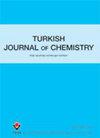Reducible tungsten(VI) oxide-supported ruthenium(0) nanoparticles: highly active catalyst for hydrolytic dehydrogenation of ammonia borane
IF 1.3
4区 化学
Q3 CHEMISTRY, MULTIDISCIPLINARY
引用次数: 0
Abstract
Reducible WO3 powder with a mean diameter of 100 nm is used as support to stabilize ruthenium(0) nanoparticles. Ruthenium(0) nanoparticles are obtained by NaBH4 reduction of ruthenium(III) precursor on the surface of WO3 support at room temperature. Ruthenium(0) nanoparticles are uniformly dispersed on the surface of tungsten(VI) oxide. The obtained Ru0 /WO3 nanoparticles are found to be active catalysts in hydrolytic dehydrogenation of ammonia borane. The turnover frequency (TOF) values of the Ru0 /WO3 nanocatalysts with the metal loading of 1.0%, 2.0%, and 3.0% wt. Ru are 122, 106, and 83 min-1, respectively, in releasing hydrogen gas from the hydrolysis of ammonia borane at 25.0 °C. As the Ru0 /WO3 (1.0% wt. Ru) nanocatalyst with an average particle size of 2.6 nm provides the highest activity among them, it is extensively investigated. Although the Ru0 /WO3 (1.0% wt. Ru) nanocatalyst is not magnetically separable, it has extremely high reusability in the hydrolysis reaction as it preserves 100% of initial catalytic activity even after the 5th run of hydrolysis. The high activity and reusability of Ru0 /WO3 (1.0% wt. Ru) nanocatalyst are attributed to the favorable metal-support interaction between the ruthenium(0) nanoparticles and the reducible tungsten(VI) oxide. The high catalytic activity and high stability of Ru0 /WO3 nanoparticles increase the catalytic efficiency of precious ruthenium in hydrolytic dehydrogenation of ammonia borane.还原性氧化钨负载钌纳米颗粒:氨硼烷水解脱氢的高活性催化剂
采用平均直径为100 nm的可还原性WO3粉末作为载体稳定钌纳米颗粒。在室温下,用NaBH4将钌(III)前驱体还原在WO3载体表面得到钌(0)纳米颗粒。钌(0)纳米颗粒均匀分布在氧化钨(VI)表面。所制得的Ru0 /WO3纳米颗粒是氨硼烷水解脱氢反应的活性催化剂。在25.0℃条件下,Ru重量分别为1.0%、2.0%和3.0%的Ru0 /WO3纳米催化剂在氨硼烷水解过程中释放氢气的周转频率(TOF)分别为122、106和83 min-1。由于平均粒径为2.6 nm的Ru0 /WO3 (1.0% wt. Ru)纳米催化剂的活性最高,因此得到了广泛的研究。虽然Ru0 /WO3 (1.0% wt. Ru)纳米催化剂不可磁分离,但它在水解反应中具有极高的可重复使用性,即使在第5次水解后也能保持100%的初始催化活性。Ru0 /WO3 (1.0% wt. Ru)纳米催化剂的高活性和可重复使用性是由于Ru0纳米颗粒与可还原性氧化钨(VI)之间良好的金属支撑相互作用所致。纳米Ru0 /WO3的高催化活性和高稳定性提高了珍贵钌在氨硼烷水解脱氢中的催化效率。
本文章由计算机程序翻译,如有差异,请以英文原文为准。
求助全文
约1分钟内获得全文
求助全文
来源期刊

Turkish Journal of Chemistry
化学-工程:化工
CiteScore
2.40
自引率
7.10%
发文量
87
审稿时长
3 months
期刊介绍:
The Turkish Journal of Chemistry is a bimonthly multidisciplinary journal published by the Scientific and Technological Research Council of Turkey (TÜBİTAK).
The journal is dedicated to dissemination of knowledge in all disciplines of chemistry (organic, inorganic, physical, polymeric, technical, theoretical and analytical chemistry) as well as research at the interface with other sciences especially in chemical engineering where molecular aspects are key to the findings.
The journal accepts English-language original manuscripts and contribution is open to researchers of all nationalities.
The journal publishes refereed original papers, reviews, letters to editor and issues devoted to special fields.
All manuscripts are peer-reviewed and electronic processing ensures accurate reproduction of text and data, plus publication times as short as possible.
 求助内容:
求助内容: 应助结果提醒方式:
应助结果提醒方式:


